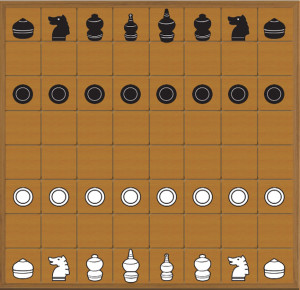Makruk – Thai Chess (หมากรุก)
Download
Makruk (Thai: หมากรุก; rtgs: Mak Ruk;), or Thai chess, is a board game descended from the 6th-century Indian game of chaturanga or a close relative thereof, and therefore related to chess. It is regarded as the most similar living game to this common ancestor of all chess variants.
There are around two million Thais who can play makruk, while 5000 can play chess.
According to former world chess champion Vladimir Kramnik, Makruk Thai is more strategic than international chess. You have to plan your operations with total care since Makruk Thai can be compared to an anticipated endgame of International Chess.

Rules
- The Pawn (called เบี้ย bia, a cowry shell, formerly used for money) moves and captures like a pawn in international chess, but cannot move two steps on the first move and, therefore, cannot be captured en passant. A pawn that reaches the sixth rank is always promoted to a queen (med).

- The Queen (called เม็ด met), the weakest piece, moves one step in any diagonal direction, like the fers in shatranj, or a cat sword in dai shogi.

- The Bishop (called โคน khon, nobleman or mask) moves one step in any diagonal direction or one step forward, like the silver general in shogi.

- The Knight (called ม้า ma, horse) moves like a knight in Western chess: two steps in one direction and then one step perpendicular to that movement. It jumps over any pieces in the way.

- The Rook (called เรือ ruea, boat) moves like a rook in Western chess: any number of steps horizontally or vertically.

- Ang moves like a king in international chess – one step in any direction. He is allowed to make a Ses (knight jump) at his first move (This special move is no more used in Thailand). The game ends when the king is checkmated.

Counting Rules (The King hunt)
When a player has only the King left and all the Fishes currently available on the board were promoted, he can claim the game drawn after the applicable rule or condition of move counting is met. The rule of move counting is determined according to the presence of the most valuable unit left on the board regardless of the other units available.
- If there are two rooks left: 8 moves
- If there is one rook left: 16 moves
- If there are no rooks left, but there are two bishops: 22 moves
- If there are no rooks or bishops left, but there are two knights: 32 moves
- If there are no rooks left, but there is one bishop: 44 moves
- If there are no rooks or bishops left, but there is one knight: 64 moves
- If there are no rooks, bishops, or knights, but queens: 64 moves
The weaker side pronounces aloud the counting of his fleeing moves, starting from the number of pieces left on the board plus 1. The stronger side has to checkmate his opponent’s king before the maximum number is pronounced, otherwise the game is drawn. During this process, the count may restart if the counting side would like to stop and start counting again.[box type=”info”]For example, doing the King hunt, if White has two rooks and a knight against a lone black king, he has three moves to checkmate his opponent (start count from 6 to 8 not from 1 , the total number of pieces, 5). If Black captures a white rook, the count does not automatically restart, unless Black is willing to do so, at his own disadvantage. However, many players do not understand this and restart the counting while fleeing the king.[/box]
